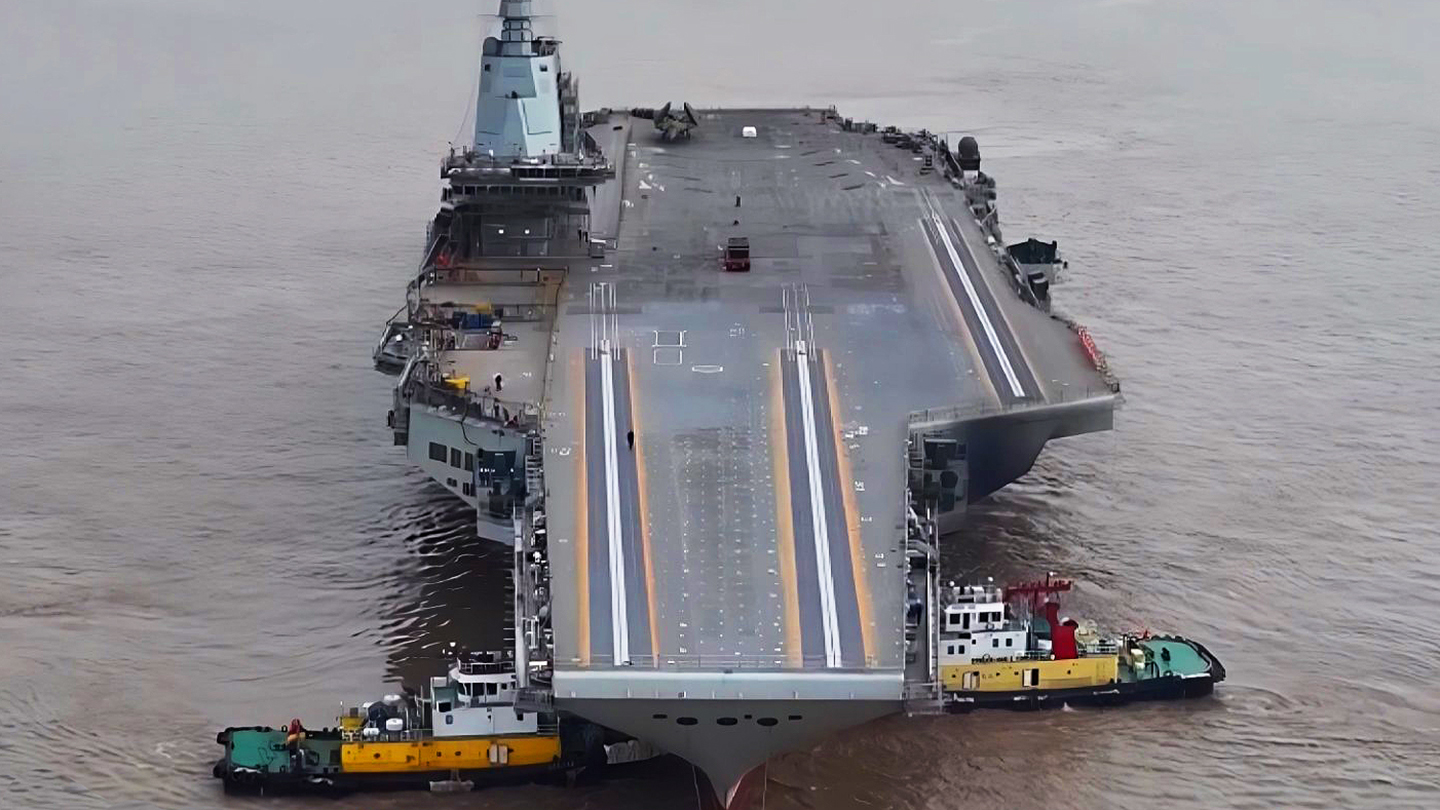Video footage released by China has given us the latest and best view of the country’s new aircraft carrier Fujian. The ship, which is the first fully Chinese-designed carrier, is set to also become the first People’s Liberation Army Navy, or PLAN, carrier to launch aircraft via catapults rather than by a ski jump. The new visuals are yet another indication that sea trials are on the horizon for the warship.
The video in question, which was released by China’s state-run CCTV network today, shows the carrier head-on as part of a short segment. CCTV says the video depicts Fujian, also known as the Type 003, completing a recent mooring test. This involves testing vessels’ main propulsion machinery while moored.
Launched in June 2022, the country’s domestically developed carrier features a catapult-assisted takeoff but arrested recovery (CATOBAR) setup, and is currently in the final stages of being fitted out at Shanghai’s Changxing Jiangnan shipyard before sea trials commence.

As part of the video, we see Fujian accompanied by two tug boats during the mooring test. What’s noticeable from the very clear imagery is how complete it looks following the full installation of its three flight deck catapults; these consist of two bow catapults and one waist catapult, positioned on the angled flight deck.
The visuals also show a mock-up Shenyang J-15 fighter to the rear of the flight deck. While the precise makeup of its airwing remains unclear at present, a catapult-variant of the J-15 fighter, the J-15T, is in existence, and will likely be a staple on this carrier. The baseline J-15 is already in service and flying from the PLAN’s two other carriers, the Type 001 Liaoning and Type 002 Shandong, both of which are short takeoff but arrested recovery (STOBAR) kinds. STOBAR carriers launch aircraft under their own power via a ski jump, before recovering them using arrester wires.
Other aircraft likely to feature as part of Fujian‘s air wing include a navalized variant of the Shenyang J-35 stealth fighter. That aircraft constitutes an evolution of the FC-31, which first broke cover in the early 2010s. The KJ-600 carrier-based airborne early warning and control aircraft will also be a key part of the air wing, along with various helicopters. It’s becoming more apparent that stealthy drones will also be part of the Fujian’s air wing, likely sooner rather than later.
While developments regarding Fujian have been well documented as of late, including by The War Zone, we had previously yet to see its newly installed catapults in any detail.
Footage of the carrier commencing catapult testing at the shipyard from late November did not show Fujian’s flight deck clearly — given that footage of said tests was captured from a distance. At least one clip was seemingly recorded by an aircraft passenger flying overhead as testing took place.
As part of those tests, a red-colored catapult ‘truck’ was used to assess the performance of Fujian’s electromagnetic aircraft launch system (EMALS) catapults. EMALS offers a range of advantages over steam-based catapults, as we’ve noted previously, including higher sortie-generation rates as a result of lower reset times. It also doesn’t require the complex piping and bulky pistol gear that is needed for a steam-powered catapult. At the same time, the technology is still relatively new and complex, but China has been testing EMALS systems on land for years now.
Since then, it’s been confirmed by Andreas Rupprecht, a Chinese military aviation expert and contributor to The War Zone, that the vessel was transferred to Jiangnan’s dry dock number four at the end of December.
Why Fujian is in dry dock exactly remains uncertain, but both Rupprecht and Alex Luck, a defense analyst, suggest that final hull cleaning could be one explanation. It isn’t uncommon for a large ship to get work done in dry dock prior to initial sea trials in order to work out known issues and to ensure the trials have the best possible shot at success. Luck also suggests that the footage released by CCTV today was most likely captured before Fujian went into dry dock but after its mooring test, evidenced by scaffolding seen around its island.

The new visuals, coupled with the recent catapult test, indicate that sea trials are very likely to begin soon; marking an important step towards eventually handing over the carrier to the PLAN, which could come as early as 2025.
Once it is in service, the PLAN will become one of only three navies worldwide to operate CATOBAR carriers, the others being the U.S. and French Navies. In the 2030s, India’s Navy is set to get a CATOBAR carrier, while the U.K. Royal Navy has looked into the possibility of adding catapult launch capability to its Queen Elizabeth class flattops. It’s also been suggested previously that India’s future CATOBAR INS Vishal will feature EMALS catapults, as will France’s New Generation Aircraft Carrier.
Beyond Fujian and its EMALS catapults, it should be noted that the PLAN has significant ambitions to expand its flattop fleet further in the future, as well as its rapidly growing big-deck amphibious assault ship cadre, which could become capable of launching a range of different aircraft in their own right. All this is part of Beijing’s vision of rivaling the U.S. Navy in its ability to control the seas and project power far from its shores.
We will keep our eyes peeled for what comes next for Fujian.
Contact the author: oliver@thewarzone.com
